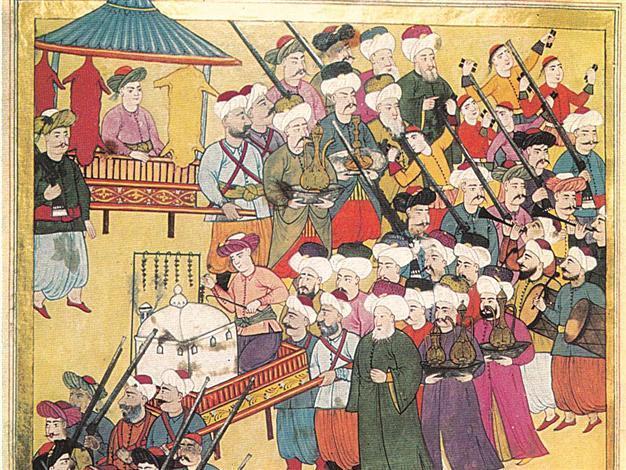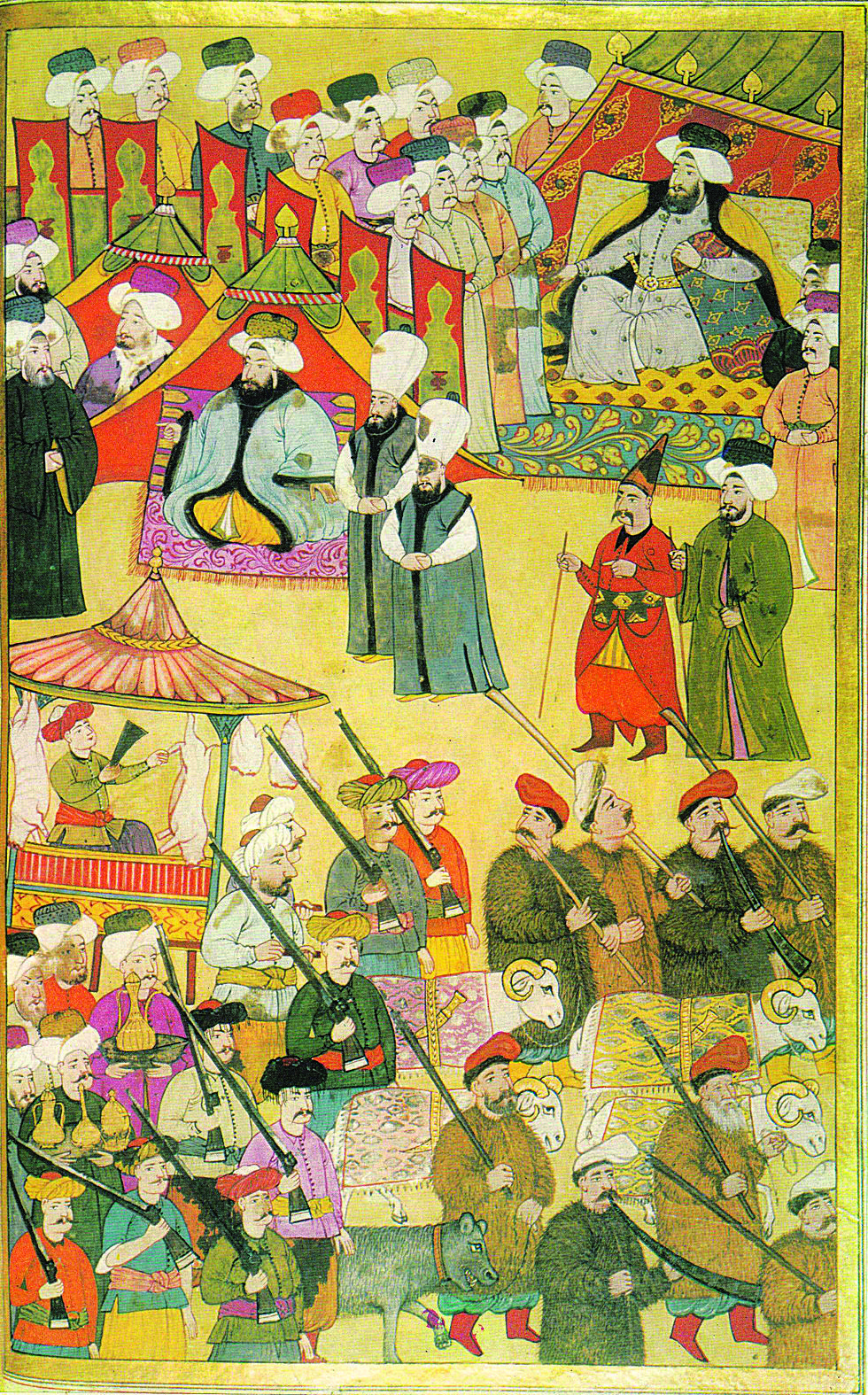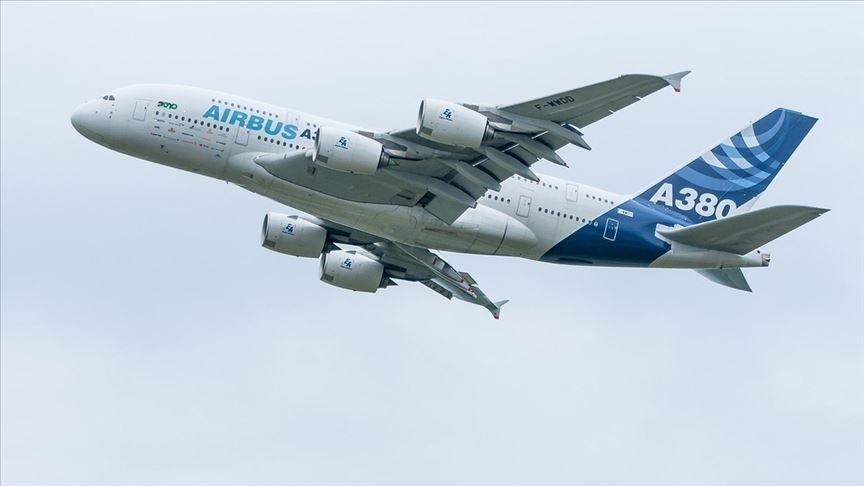Right on target in Okmeydanı, the field of archery
Niki GAMM

The circumcision festival at Okmeydanı from the Surnama-i Vehbi, 1720.
Once upon a time many centuries ago, the hills and slopes of the area known today as Okmeydanı were covered in trees, bushes and meadows. Over time, as Byzantium expanded, wood cutters’ huts would spring up and later hunting lodges for game would have been plentiful. But Fatih Sultan Mehmed’s conquest of Constantinople in 1453 changed that when he designated Okmeydanı his field of archery (ok, arrow; meydanı, open space).Throughout the centuries, Turks have been identified with their love of horses and their ability to conduct warfare on horseback using bow and arrows. As they migrated from Central Asia and took their place in the armies of Selahatin Eyyubi against the Crusaders and among the Mamlukes of Egypt from the 12th century onwards, they maintained their identity and fighting abilities. And as the nomadic Turkish tribes entered Anatolia, they brought their brand of successful warfare with them.
As the Ottoman Turks rose in power in the 13th century and after they established their capital at Bursa, Sultan Orhan is known to have established an archery field there, while Sultan Bayezid I later set up a similar target area at Gallipoli.
The Turkish bow was one of the most feared weapons in use until the age of gunpowder. In spite of its slender appearance, it was extraordinarily capable of sending arrows distances of over 400 meters. Generally it was made of maple with the addition of other materials.
 The first building at Okmeydanı
The first building at OkmeydanıAccording to information provided by the Okçular Vakfı (Archers’ Foundation), after the conquest, a lodge was set up in Okmeydanı for equestrian and archery sports that still exist today, albeit in a somewhat different form. The Okmeydanı lodge opened every year on May 6 or Hıdırellez Day and courses were given every Monday and Thursday for six months. To participate, the şeyh or leader of the lodge had to give his approval.
While there is some thought that Fatih Sultan Mehmed may have established his army headquarters here and even constructed the ships that he launched on the Golden Horn during the siege of Constantinople, historical sources of the time don’t bear this out. And it’s only first mentioned in a 17th-century history. That doesn’t rule out the fact that Fatih at some point saw the Okmeydanı area as suitable for military exercises and even as an army camp.
It has been suggested that, following the conquest, the grand vizier organized a victory celebration here. The area may even have served as a central place to divide up the spoils of the conquest. Fatih Sultan Mehmed had a masjid built at Okmeydanı but the building depicted in Matrakçı Nasuh’s 1537 depiction of Okmeydanı shows a structure, although it doesn’t resemble a religious structure.
In the trust deed for the foundation that Fatih set up, there is no mention of the word Okmeydanı; that was left to his son and successor Sultan Bayezid II (r. 1481-1512). As the 15th century drew to a close, more and more people – particularly Turks – migrated to Istanbul, including leaders and members of a number of Sufi dervish orders.
Most likely, the Okmeydanı Lodge was established at this time and is the building shown in the Matrakçı Nasuh picture which seems to be a mansion or large room, masjid and storage area.These buildings eventually fell to wrack and ruin but were restored around 1625, just a few years before Hezarfen Ahmed Çelebi practiced his flying skills eight or nine times at Okmeydanı, according to the 17th-century travel writer Evliya Çelebi. Then Hezarfen Ahmed Çelebi flew from the top of Galata Tower to Üsküdar under the amazed eyes of Sultan Murad IV and the people of Istanbul. Afterward, Okmeydanı became a winter headquarters for the army.
From archery field to festivals
We next hear of Okmeydanı when Sultan Ahmed III turned into a festival ground for the celebration of the circumcisions of his four sons in 1720, although it was undoubtedly used as a preferred location for festivities and celebrations over time. These sorts of activities were originally held in the Atmeydanı or Hippodrome, but it became too small and too identified with rebellions on the part of the Janissary forces. The celebration that we know the most about is that held for the circumcisions of Sultan Ahmed III’s four young boys. This was lavishly illustrated by Levni in the Surnama-ı Vehbi and allows us to see much of what such occasions entailed.
“The festival arranged by Ahmed III to celebrate the circumcision of his four sons in 1720 lasted for 15 days and nights, taking place at Okmeydanı and in waterside pavilions. Tents were set up at Okmeydanı for the sultan, grand vizier, and other guests, and the water festival was viewed from palaces along the shore. The guilds also took part in the festivities, parading in a procession, displaying their skills and merchandise and presenting gifts,” according to Nurhan Atasoy and Filiz Çağman in “Turkish Miniature Paintings.”
One of the more acute observers of Ottoman society in the early 18th century was Lady Mary Wortley Montague, the wife of the British ambassador (1716-1718), who wrote a series of letters to her relatives and friends in Britain. In one of them, she describes how she had an opportunity to observe the sultan at target practice. Much to her amusement, she noticed that the sultan (Ahmed III) may have claimed to be a great archer, but his servants moved the targets around so that appeared he was more accurate than he actually was. As the nişan taşı (target) was normally made of stone, does this mean temporary targets might have been made of other substances such as wood?
The Okçular Lodge was rebuilt by Sultan Mahmud II in 1818-1819 and resembled something like a neighborhood masjid. It was a two-story building of two sections with a wide rectangular courtyard in front surrounded by a high wall.
Today, almost the entire area is covered with buildings although under Fatih Sultan Mehmed’s foundation deed, no buildings were allowed. Of the hundreds of nişan taşı targets set up, only 200 or so still remain in good condition, such as that of Hacı Beşir Ağa, Aynalıkavak Kasrı and Kececi Piri Paşa.
















